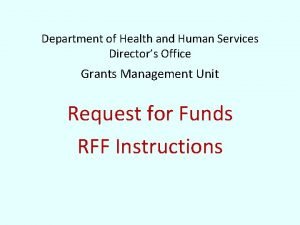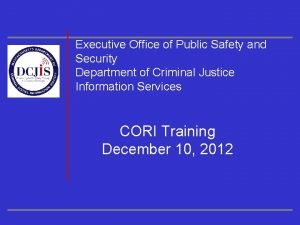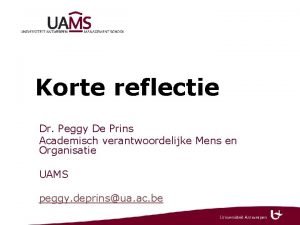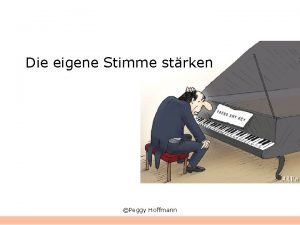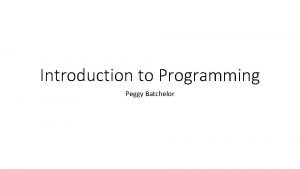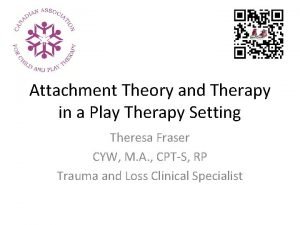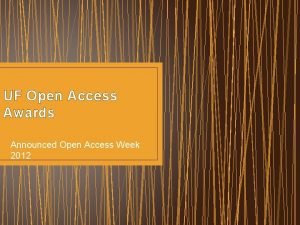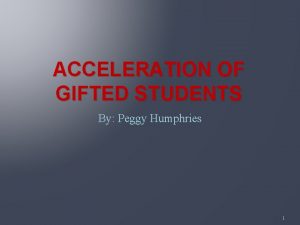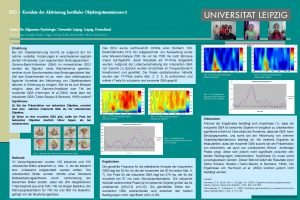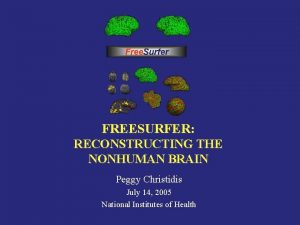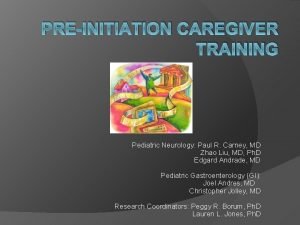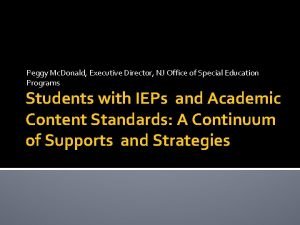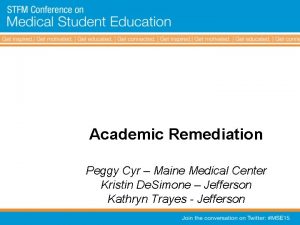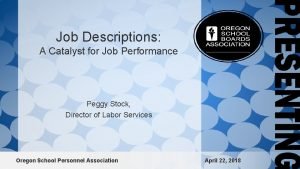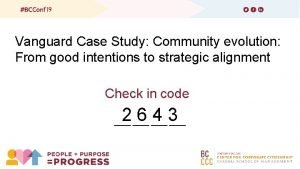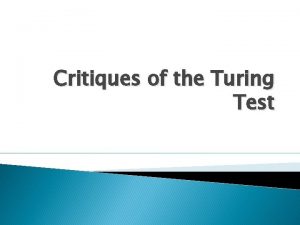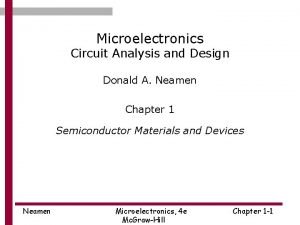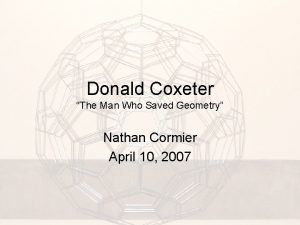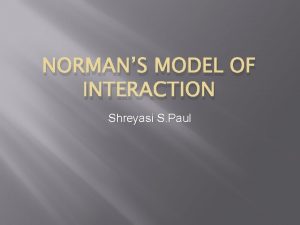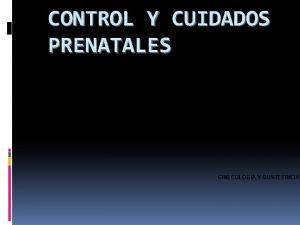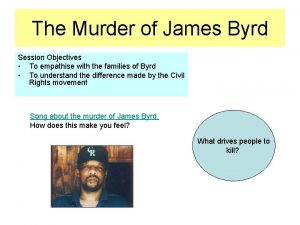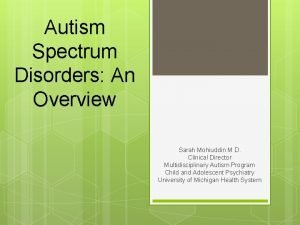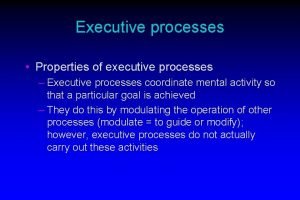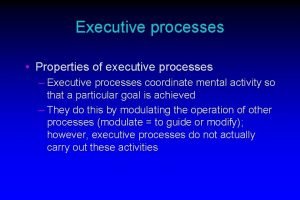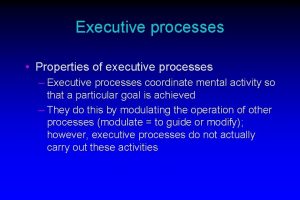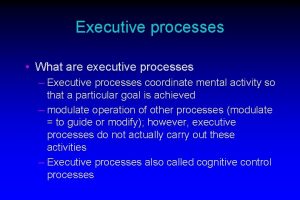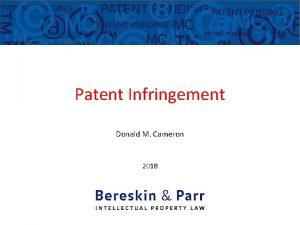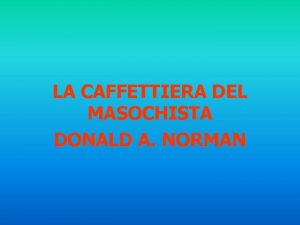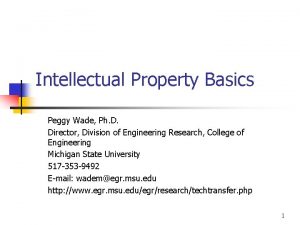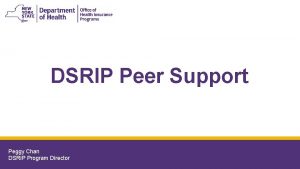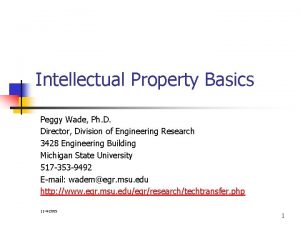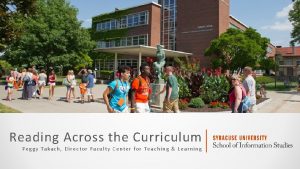Peggy Mc Donald Executive Director NJ Office of






































- Slides: 38

Peggy Mc. Donald, Executive Director, NJ Office of Special Education Programs Students with IEPs and Academic Content Standards: A Continuum of Supports and Strategies

Agenda �Review strategies and supports to align instruction for students with IEPs with gradelevel academic standards �Learn about NJ district approaches to the alignment process

IDEA says… �(1) Special education means specially designed instruction, at no cost to the parents, to meet the unique needs of a child with a disability… 34 CFR Sec 300. 39(a)(1)

IDEA says… �Specially designed instruction means adapting, as appropriate to the needs of an eligible child under this part, the content, methodology, or delivery of instruction (i)To address the unique needs of the child that result from the child’s disability; and (ii) To ensure access of the child to the general curriculum, so that the child can meet the educational standards within the jurisdiction of the public agency that apply to all children.

Adapting… �Content Adjust text complexity range (lexiles) Add foundational skills (phonemic awareness/phonics) Functional Skills (ADL, Mobility)

IDEA says… �All children with disabilities are included in all general State and districtwide assessment programs, including assessments described under …the Elementary and Secondary Education Act of 1965, with appropriate accommodations and alternate assessments where necessary and as indicated in their respective IEPs. ” 20 USCS Sec. 1412(a)(16)

IDEA says… �The State must— (a) Have in effect established goals for the performance of children with disabilities in the State that— … (2) Are the same as the State's objectives for progress by children in its definition of adequate yearly progress, including the State's objectives for progress by children with disabilities, under section 1111(b)(2)(C) of the ESEA, 20 U. S. C. 6311;

IDEA says… �(4) Are consistent, to the extent appropriate, with any other goals and academic standards for children established by the State;

�(b) Support and facilitation. State rules, regulations, and policies under Part B of the Act must support and facilitate LEA and school-level system improvement designed to enable children with disabilities to meet the challenging State student academic achievement standards. 34 CFR Sec. 300. 199(3)

IDEA and Placement �A child with a disability is not removed from education in age- appropriate regular classrooms solely because of needed modifications in the general education curriculum. 34 CFR Sec. 300. 116(e)

IDEA and the IEP �A statement of the child's present levels of academic achievement and functional performance, including-- (i) How the child's disability affects the child's involvement and progress in the general education curriculum (i. e. , the same curriculum as for nondisabled children); 34 CFR Sec. 300. 320(a)(1)(i)

IDEA and Goals and Objectives �(2)(i) A statement of measurable annual goals, including academic and functional goals designed to-- (A) Meet the child's needs that result from the child's disability to enable the child to be involved in and make progress in the general education curriculum; � 34 CFR Sec. 300. 320(a)(2)

Alignment �Running Parallel…

Federal Register �Alignment with the state’s academic content standards means that the State has defined clearly the connection between the instructional content appropriate for nondisabled students and the related knowledge and skills that may serve as the basis for a definition of proficiency.

A Model of ‘Alignment’ Standards Curriculum Instructional Units Learning Objectives IEP Goals and Objectives

A Closer Look: Curriculum • Learning Objectives • Materials • Methods • Assessments Standards

Curriculum � Learning Objectives Study skills, executive functioning � Differentiated Teaching Strategies UDL Principles Flexible Grouping Supplemental Instruction – Reteach/Enrich � Accessible Instructional Materials Leveled texts, software, supplementary programs Manipulatives � Assessment Alternate Assessments Accommodations and Modifications

Curriculum �Methods Scheduling Pacing

A Closer Look: Instructional Units Grade Level Content Organized into Units of Study Standards

A Closer Look: Instructional Units Standards The curriculum for a specific grade and subject can be broken down into several instructional units. Curriculum Grade 2 English Language Arts Instructional Unit 1 Unit 2 Unit 3 Unit 4 Unit 5

• Organized into Instructional Units from Curriculum • Organized by Chronological Grade Level A Closer Look: Learning Objectives Standards

Standards A Closer Look: Learning Objectives Curriculum: Grade 2 English Language Arts Instructional Unit Grade 2 English Language Arts: Unit 1 1: Ask and answer such questions as who, what, where, when, why, and how to demonstrate understanding of key details in a text. Know and apply grade-level phonics and word analysis skills in decoding words. With guidance and support from adults and peers, focus on a topic and strengthen writing as needed by revising and editing.

A Closer Look – IEP Objectives Standards Curriculum Instructional Units Learning Objectives IEP Goals and Objectives Embedded Skills • Foundational Skills • Other Needs: • Social Skills • Organizational Skills • Motor Skills

A Closer Look: IEP Goals and Objectives Standards Curriculum: Grade 2 English LA Instructional Unit 1 Learning Objective: Ask and answer such questions as who, what, where, when, why, and how to demonstrate understanding of key details in a text. IEP Goal : The student will answer “who”, “what” and “where” questions based on a text at the independent reading level. Learning Objective IEP Goal: Learning Objective: RL. 2. 1: Ask and answer such The student will questions as who, what, answer “where”, where, when, why, and how to “when”, “why” and demonstrate understanding of “how” questions based key details in a text. on a familiar text. Learning Objective IEP Goal: Learning Objective: The student will be RL. 2. 1: Ask and answer such questions as who, what, able to create “WH” where, when, why, and how to questions based on key demonstrate understanding of details in an key details in a text. informational text.

A Closer Look: IEP Goals and Objectives Standards Curriculum: Grade 5 Math Instructional Unit 3 Learning Objective: Use equivalent fractions as a strategy to add and subtract fractions. . IEP Goal: The student will identify parts vs. wholes Learning Objectives: Add and subtract fractions (including mixed numbers) with unlike denominators. Learning Objective: IEP Goal: RL. 2. 1: Ask and answer such The student will questions as who, what, where, when, why, and how to separate whole demonstrate understanding of objects and groups key details in a text. into parts Learning Objective: RL. 2. 1: Ask and answer such questions as who, what, where, when, why, and how to demonstrate understanding of key details in a text.

A Closer Look: IEP Goals and Objectives Standards Curriculum: Grade 5 Math Instructional Unit 3 Learning Objective: Use equivalent fractions as a strategy to add and subtract fractions. . IEP Goal: Student will increase appropriate social responses to peers by responding to greetings in four out of five opportunities Learning Objectives: Add and subtract fractions (including mixed numbers) with unlike denominators. Learning Objective: IEP Goal: RL. 2. 1: Ask and answer such questions as who, what, The student will add where, when, why, and how to and subtract fractions demonstrate understanding of with like denominators key details in a text. Learning Objective: RL. 2. 1: Ask and answer such questions as who, what, where, when, why, and how to demonstrate understanding of key details in a text.

Supports �‘Unpacking’ the Standards �Universal Design For Learning �Scaffolds �Accommodations/Adaptations �Foundational/Embedded/Essential Skills �Essential Elements

Standard Unpacking Standard Unpacked 1. Write arguments to support 1. Write opinion pieces on topics or texts, supporting a claims in an analysis of point of view. substantive topics or texts, using a. Introduce a topic or text clearly, state an opinion, and valid reasoning and relevant and create an organizational structure in which ideas are sufficient evidence. logically grouped to support the writer’s purpose. b. Provide logically ordered reasons that are supported by facts and details. c. Link opinion and reasons using words, phrases, and clauses (e. g. , consequently, specifically). d. Provide a concluding statement or section related to the opinion (North Carolina Department of Education)

Universal Design for Learning �set of principles for curriculum development that give all individuals equal opportunities to learn �provides a blueprint for creating instructional goals, methods, materials, and assessments that work for everyone--not a single, one-size -fits-all solution �flexible approaches that can be customized and adjusted for individual needs cast. org

Scaffolding �Instructional scaffolding Adding supports for students in order to enhance learning and aid in the mastery of tasks systematically building on students’ experiences and knowledge as they are learning new skills temporary and adjustable As students master the assigned tasks, the supports are gradually removed ▪ http: //iris. peabody. vanderbilt. edu

Scaffolding �W 3. 1 Write opinion pieces on topics or texts, supporting a point of view with reasons. Express a point of view about text Support a point of view about text – find the evidence Write opinion supporting a point of view with evidence Varied text complexity

Accommodations/Adaptations �Read aloud �Extended Time �Calculator �Graphic Organizers �Audio Texts �Consistency between instruction and assessment � http: //www. parcconline. org/

Foundational Skills �Concepts of Print �Phonological Awareness �Phonics and Word Recognition �Fluency

Essential Elements �Specific statements of knowledge and skills linked to grade-level expectations indentified in college and career readiness standards Aligned with Common Core State Standards

Linkage Levels Initial Precursor: Typically reflect foundational nodes in the learning map Distal Precursor: Nodes on map between target and foundational Proximal Precursor: Nodes on map between target and foundational Target – Closest to the knowledge and skills reflected in the Essential Element Successor – Designed to give students the opportunity to stretch toward content in the general education grade level standard

Claim 1 - Number Sense: Students demonstrate understanding of increasingly complex numbers An example – Math Claim 1 – Number Sense: Students demonstrate increasingly complex understanding of numbers MC 1. 1 Understand number structures (counting, place value, fraction) MC 1. 2 Compare, compose, and decompose numbers and sets MC 1. 3 Calculate accurately and efficiently using simple arithmetic operations. K. CC. 1, 4, 5 1. NBT. 1 a-b 2. NBT. 2 a-b, 3 3. NBT. 1, 2, 3 3. NF. 1 -3 4. NF. 1 -2, 3 5. NF. 1, 2 6. RP. 1 7. RP. 1 -3 7. NS. 2. c-d 8. NS. 2. a Claims Conceptual Areas Essential Elements EE. 3. NBT. 2. Demonstrate understanding of place value to tens. Target Node – Explain place values for ones and tens Proximal – recognize multiple tens and something; compose numbers based on ten Distal – Recognize a unit; explain ten as a composition of ten ones Initial – Recognize separateness; recognize set Nodes & Connections

Sample Map

NJDOE RESOURCES �www. state. nj. us Model curriculum (under revision) ELL scaffolds Instructional Supports Njcore. org Special education resources Learning Resource Centers Positive Behavioral Supports in Schools
 Eft director's office
Eft director's office Executive office of the president
Executive office of the president Executive office of the president
Executive office of the president Page 38
Page 38 Peggy de prins
Peggy de prins Peggy boylan-ashraf sjsu
Peggy boylan-ashraf sjsu Peggy hoffmann
Peggy hoffmann Bishop peggy johnson
Bishop peggy johnson Peggy batchelor
Peggy batchelor Rudolph schaffer and peggy emerson
Rudolph schaffer and peggy emerson Peggy de maesschalck
Peggy de maesschalck Sophia acord uf
Sophia acord uf Peggy humphries
Peggy humphries Peggy dobrig
Peggy dobrig Peggy christidis
Peggy christidis Peggy borum uf
Peggy borum uf Peggy brickman
Peggy brickman Peggy parish
Peggy parish Peggy mcdonald njdoe
Peggy mcdonald njdoe Peggy burns harvard
Peggy burns harvard False necessity trap
False necessity trap Peggy
Peggy Kewirausahaan menurut peggy dan charles
Kewirausahaan menurut peggy dan charles Peggy cyr
Peggy cyr Peggy job description
Peggy job description Kappa delta pi dr. peggy moch
Kappa delta pi dr. peggy moch Peggy tate
Peggy tate Factory office layout
Factory office layout Donald giannella
Donald giannella Subarticulate
Subarticulate Nlveamen
Nlveamen Phillips 6 6
Phillips 6 6 Donald coxeter
Donald coxeter Donald geesaman
Donald geesaman Norman model of interaction
Norman model of interaction Dieta menopausa dott migliaccio
Dieta menopausa dott migliaccio Donald byrd murder
Donald byrd murder Donald f kuratko
Donald f kuratko Sarah mohiuddin
Sarah mohiuddin
